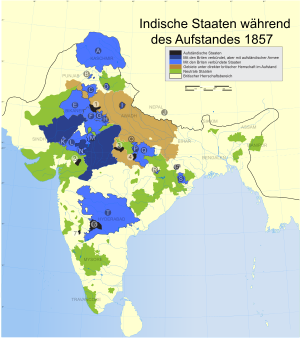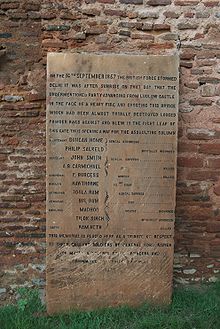Indian Rebellion of 1857
Indian Uprising of 1857

Map of the Indian subcontinent
Black: rebellious princely states.
Blue: Princely States that remained loyal to the British, but where there were military conflicts with insurgent troops.
Light blue: princely states that supported the British side.
Ochre: British territories that were affected by the rebellion.
Green: neutral states.
The Indian Rebellion of 1857, also called the Sepoy Rebellion, was directed against the colonial rule of the British East India Company over the Indian subcontinent. The insurgency was predominantly confined to the Upper Ganga Valley and Central India. Centres of the insurgency were Uttar Pradesh, Bihar, northern Madhya Pradesh and the Delhi region.
The beginning of the Indian Rebellion of 1857 is usually dated to May 10, 1857. On that day, Hindu and Muslim soldiers openly revolted against their British commanders in Merath. The mutinous troops withdrew to Delhi, which was already in the hands of the insurgents on May 11. In Delhi, as before in Merath, there were killings of British and Eurasians as well as of Indians who had converted to Christianity. These massacres involved not only sepoys but also sections of the Indian civilian population. In the weeks and months that followed, the insurgency spread across northern India. Individual British garrisons such as Lakhnau and Kanpur defended themselves - partly with the help of sepoys who remained loyal - for several weeks against a superior number of insurgent troops. The murder of British civilians was taken by British troops as justification for a warfare that was already judged by contemporaries to be inappropriately cruel and ethically dubious. In Indian historiography, Lakshmibai, Rani of Jhansi, occupies a special place. The princess joined the revolt reluctantly and decided to actively support it only when she saw it as the only way to secure her family's claim to power. She was killed in action at Khota-ki-Serai near Gwalior on 17 June 1858. The rebellion had already been largely decided in favour of the British in the course of 1858. In 1859 there were still isolated clashes; the Indian Rebellion, as generally understood, did not end until that year. After the suppression, the East India Company was dissolved by the Government of India Act 1858 and British India became a formal Crown Colony.
The riot is generally considered to have been triggered by the introduction of the Enfield rifle, whose paper cartridges were treated with a mixture of beef tallow and lard, according to a rumor widespread among British Indian forces. Since the cartridges had to be bitten open before use, their use was a violation of their religious observances for devout Hindus and Muslims alike. The real causes are considered to be the social and economic policies pursued by the British East India Company, as a result of which large sections of the Indian population lost land rights, employment opportunities and influence, the increasing efforts to Christianize India in the 19th century, and the annexation of Indian princely states through the application of the Doctrine of Lapse. There is no consensus in historiography as to which of these factors should be given particular weight. Historians have also weighted the causes of the revolt very differently depending on their own cultural, religious and political standpoint.
Places of remembrance of the 1857 uprising
A number of buildings and places that played a role during the uprising of 1857 are today commemorated with memorials and grave monuments as well as information boards to the events of the years 1857 to 1859. The Red Fort in Delhi has been a Unesco World Heritage Site since 2007. Among other things, the private audience hall (Diwan-i-Khas), in front of which the rebellious sepoys gathered on May 11, 1857, is open to the public there. The Kashmir Gate in Delhi, which was the site of fierce fighting at the beginning of the rebellion and during the reconquest, is now a national monument. In the St. James Church near it, numerous plaques commemorate British regiments as well as individuals who played a role during the Indian uprising. In Merath, the graveyard of the former British garrison contains the graves of the British casualties who died on the evening and night of May 10, 1857. Sikandar Bagh, where many Indians perished during the reconquest of Lakhnau, has been rebuilt and now houses the National Botanical Research Institute of India. On the site where the Kanpur garrison defended itself for weeks, a large church was erected by the British shortly after the end of the rebellion, which still stands today, with stone tablets recording the names of British persons who died during the siege. In the ground around the church stones mark the course of the defensive rampart. Around the well into which the victims of the Bibighar massacre were thrown, a park was designed by the British, which was accessible only to Europeans and Indian Christians until India's independence. The park was redesigned after India's independence. Monuments in the park commemorate Nana Sahib and Tantya Tope. The tree on which the British hanged hundreds of Indians in 1857, even if there was only a slight reason to suspect that they were involved in the massacres, is also in the park. The tree has since fallen.

Memorial plaque for the fallen British soldiers of the York and Lancaster reg. in York Minster

Stone tablet at Kashmir Gate commemorating the recapture on September 14, 1857.
Bibliography
- Harold E. Raugh Jr: The Raugh bibliography of the Indian Mutiny, 1857-1859. Helion, Solihull 2015. 903 pp - "Quite a definitive bibliography" (Raugh).
Questions and Answers
Q: What is the Indian Rebellion of 1857?
A: The Indian Rebellion of 1857 was a mutiny of sepoys of the British East India Company's army that began on 10 May 1857 at Meerut.
Q: What are some other names for the Indian Rebellion of 1857?
A: The Indian Rebellion of 1857 is also called the Great Indian Event of 1857, the Indian Mutiny, the Sepoy Mutiny, India's First War of Independence or India's First Struggle for Independence.
Q: When did the Indian Rebellion of 1857 start?
A: The Indian Rebellion of 1857 began on May 10, 1857 at Meerut.
Q: Who rebelled in the Indian Rebellion of 1857?
A: Sepoys in the Presidency of Bengal revolted against their British officers.
Q: What was one of the main factors leading to the Indian Rebellion of 1857?
A: One of the main factors leading to the Indian Rebellion of 1857 was the sepoys' anger and frustration with the British East India Company's policies.
Q: How did the British respond to the Indian Rebellion of 1857?
A: The British East India Company responded to the Indian Rebellion of 1857 with a brutal and bloody suppression of the uprising, which resulted in the loss of many lives.
Q: Why is the Indian Rebellion of 1857 significant?
A: The Indian Rebellion of 1857 is significant because it marked the beginning of the end of British colonialism in India and inspired later Indian freedom struggles against British rule.
Search within the encyclopedia